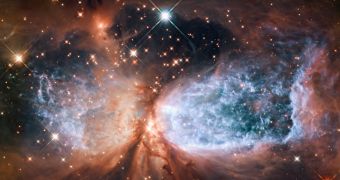Despite their not-so-impressive size and mass, dwarf galaxies pack one really wicked star-forming punch, and played a crucial role in shaping the universe, NASA and ESA researchers argue in a paper in The Astrophysical Journal.
Thus, scientists say that, according to evidence at hand, dwarf galaxies have the potential to be far more prolific than previously assumed, and are likely to have birthed quite many of the stars that the universe holds.
Writing in The Astrophysical Journal, specialists detail that, even now, new stars are coming into being all across the universe. However, the heydays of star formation were those between 2 and 6 billion years following the Big Bang, they add.
Hence, it is this 2 to 6 billion years timespan that researchers looking to understand the formation and the evolution of the Universe must focus on. More precisely, the galaxies whose makeup and behavior need be investigated are so-called starbursting ones.
As detailed by NASA and ESA scientists, starbursting galaxies are galaxies that form new stars at a rate much faster than that documented in the case of regular galaxies. Interestingly enough, previous studies chiefly focused on starbursting mid-range or high-mass galaxies.
Now that starbursting dwarf galaxies have also received their fair share of attention, it appears that researchers owe them an apology for having ignored them in the past and for not having given them credit for all their hard work birthing stars.
Simply put, observations provided by the NASA/ESA Hubble Space Telescope indicate that, as small as they might be, dwarf galaxies can cough out an impressive number of stars should they set their minds to it, and must therefore have played a major role in the early history of the universe.
“These galaxies are forming stars so quickly that they could actually double their entire mass of stars in only 150 million years – this sort of gain in stellar mass would take most normal galaxies 1-3 billion years,” researcher Jean-Paul Kneib says in a statement.
“We already suspected that dwarf starburst galaxies would contribute to the early wave of star formation, but this is the first time we’ve been able to measure the effect they actually had. They appear to have had a surprisingly significant role to play during the epoch where the Universe formed most of its stars,” adds specialist Hakim Atek.
In order to investigate the contribution of dwarf galaxies to the formation of the universe, researcher used Hubble's Wide Field Camera 3, which made it possible for them to obtain information concerning the behavior and appearance of low-mass dwarf galaxies in the distant Universe.

 14 DAY TRIAL //
14 DAY TRIAL //